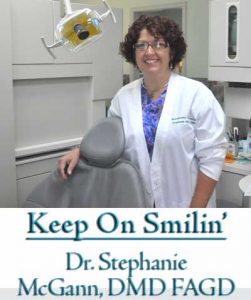By Dr. Stephanie McGann, DMD FAGD, Columnist, The Times
 I don’t have to tell anyone that the world we knew just a few short weeks ago has been forever altered thanks to a tiny viral invader. What’s important to know is that many changes need to be made as a result of how we as a country handled this.
I don’t have to tell anyone that the world we knew just a few short weeks ago has been forever altered thanks to a tiny viral invader. What’s important to know is that many changes need to be made as a result of how we as a country handled this.
Now – before anyone looks for me with pitchforks and torches, I am not on a political crusade, I am pointing out flaws in our system that allowed us to slip to this level of disaster.
Let’s take a look at our healthcare insurance system. They have done a lot of things right yet they have a part to play in this.
First, hospitals, doctors and other providers have over time found it has become essential to remain in business to be “in-network.” What that means is essentially, your front line of care has agreed to a fixed deeply discounted fee for your particular flavor of policy in order to keep your business. Some of those contracts leave meager to no profit for providers to develop any sort of stockpile of supplies. To stay in business with these incredibly low fees, hospitals have been forced to implement strict inventory management systems that only allow a re-order when the amount on hand falls to a predetermined level.
Everyone thinks (or at least used to think) that doctors and hospitals were gouging patients, so this forced cost containment was a good thing. It’s gotten way out of hand. You know it’s bad when most providers are telling their kids not to consider following them into the medical profession, you just can’t recover the costs of the education, let alone the pay for the stress level is inadequate.
Look at your explanation of benefits, look at what was paid for a single visit, remember that visit fee includes the person who scheduled your appointment, the cleaning crew, the nurse that took your vitals, the disposables that were used, and the facility and equipment. In some cases the doctor fee is separate, but not always.
Suddenly that $45.00 for that office visit looks paltry for the costs involved in providing your care.
What may come of this?
1. Hospitals and providers will need a way to fund a supply system that doesn’t involve urgently ordering PPE on eBay or Amazon.
2. In-network contracts will all need to be reviewed or many providers will be forced to leave.
3. Americans and American workers have rights to personal protections, I hope that future hospital contracts will include disaster supply funding or insurance carrier stockpiles for in-network providers. On the positive side, insurance companies have stepped up and some are waiving all out of pocket fees for COVID-19 related visits. I’m sure, however, this will all be recouped in higher premiums next year.
The second wave of crisis will come when our healthcare workers are sick, and their employers are faced with charges of not providing the appropriate PPE as required by law. There are lawyers already looking to cash in on Occupational Safety and Health Administration (OSHA) claims. There are hospitals that will go under these crushing legal expenses.
We’ve all heard about government stockpiles. To be honest, the whole point of a federal stockpile is that it makes more sense to have one and send it where it’s needed than to have every state pay for, maintain, warehouse and resupply expired materials. This is simple economics that was solved years ago but somehow got forgotten in these wild times. Not to mention the maintenance of the equipment in our federal stockpiles was lapsed.
Once upon a time, your healthcare provider could charge a patient a fee based on what was actually needed. This week alone as I am seeing only the worst dental emergencies, my PPO “allowances” for the work I did do was far less than the cost of the PPE. I lose money every time I open my door to see an emergency. This can’t go on very long.
I am working on getting just two N-95 masks for myself and one team member. The cost is $300.00 Just one more cost I will need to absorb if I am to return to practice someday.
Would single payer help?
On many fronts, yes, materials and supplies would be centrally sourced. The cost savings from such bulk buying alone would be huge. Hospitals would not have to employ teams of people just to manage the thousands of different insurance policies that patients present with. The right hand would be connected to the left hand.
Today, if you have a test at a hospital that is part of one healthcare system and then see a physician who is affiliated with another, you spend hours getting records from one to another. For those of use locally think MainLine Health and Penn Medicine.
Sure, there are issues and it’s really too big a leap for us yet, but public options for some or even a unified communication and supply system would be a great start.
Will we get back to business as usual? Probably never exactly the same again. Changes will be coming and in my opinion, it’s about time.
Dr. Stephanie McGann, who has more than two decades of dental practice experience, is a resident of the Unionville area and owns and practices at Rainbow Valley Dental, in Valley. She is a past President of the Chester/Delaware Dental Society and she is a Fellow of the Academy of General Dentistry.






